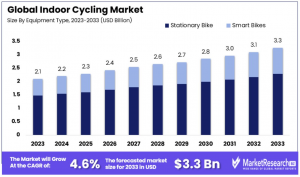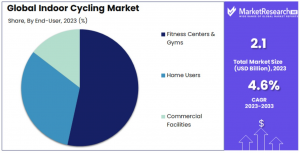Indoor Cycling Market to Reach USD 3.3 Bn by 2033, Growing at a CAGR of 4.6%
Indoor Cycling Market size is expected to be worth around USD 3.3 Billion by 2033, from USD 2.1 Billion in 2023, growing at a CAGR of 4.60%.
The Global Indoor Cycling Market size is expected to be worth around USD 3.3 Billion by 2033, from USD 2.1 Billion in 2023, growing at a CAGR of 4.60% during the forecast period from 2024 to 2033.
The Indoor Cycling Market refers to the segment of the fitness and wellness industry focused on stationary cycling equipment, platforms, and virtual cycling classes. It includes products such as stationary bikes, smart fitness equipment, cycling subscriptions, and software platforms designed for a connected, home-based workout experience. The market encompasses both individual consumers and fitness clubs looking to provide cycling-based fitness solutions.
The Indoor Cycling Market has experienced significant evolution, driven by the increasing demand for home fitness solutions and the growing popularity of virtual workout experiences. With consumers moving toward flexible, convenient, and engaging fitness options, indoor cycling has carved a strong niche.
Leading companies in this space are integrating advanced technologies like AI, real-time performance tracking, and virtual group classes to enhance user experience and engagement. Additionally, consumer preferences for health, wellness, and connected fitness are expected to continue shaping market dynamics. As a result, this market is set for steady growth, attracting both established fitness equipment brands and new entrants.
The Indoor Cycling Market is expected to continue its growth trajectory due to an increased focus on health and fitness, particularly in the post-pandemic era. As more individuals invest in at-home fitness solutions, the demand for indoor cycling equipment and online classes has surged. Government initiatives to promote public health and fitness through infrastructure development and subsidies in certain regions have further fueled market growth.
However, the sector is also subject to various regulations, particularly related to product safety standards and data privacy concerns related to connected fitness devices. Companies operating in this space must remain agile to comply with evolving regulations while ensuring consumer satisfaction through high-quality, safe products.
For both new and established players, the Indoor Cycling Market presents multiple opportunities for growth. New players can capitalize on niche segments by offering innovative, affordable solutions or specialized services like personalized coaching, AI-driven training programs, and subscription models.
Existing players can expand their market share by upgrading their product offerings, enhancing user experience, and focusing on regional diversification. Additionally, forming partnerships with fitness influencers, health clubs, and wellness communities can help strengthen brand visibility and engagement. The growing adoption of virtual cycling platforms provides a unique opportunity for businesses to tap into the global trend of interactive, remote fitness solutions.
Curious About Market Trends? Request Your Complimentary Sample Report Today: https://marketresearch.biz/report/indoor-cycling-market/request-sample/
Key Takeaway
Market Value: The Global Indoor Cycling Market is forecasted to reach USD 3.3 Billion by 2033, experiencing substantial growth from its 2023 value, with a CAGR of 4.60% during the forecast period from 2024 to 2033.
Dominant Segments:
Equipment Type Analysis: Stationary bikes hold a dominant 70% market share due to their accessibility, versatility, and affordability, appealing to a wide demographic.
End User Analysis: Fitness centers & gyms constitute the largest segment (55% market share), offering structured workouts and professional guidance.
Distribution Channel Analysis: Online retail is gaining prominence due to its convenience, wide product range, and ease of comparison.
Regional Analysis: North America dominates the market with a 37% market share, followed by Europe with 27%, driven by factors such as wellness emphasis, strong cycling culture, and technological adoption.
Use Cases
Home Fitness Revolution: With the rise of home workouts, indoor cycling has gained massive popularity. Companies are capitalizing on this trend by offering high-tech indoor cycling equipment, such as smart bikes with built-in screens for live-streamed cycling classes. This provides a convenient and immersive workout experience for users without needing to leave their homes, aligning with the growing demand for at-home fitness solutions.
Corporate Wellness Programs: Businesses are incorporating indoor cycling as part of their corporate wellness programs. Offering employees access to indoor cycling sessions or providing bikes for office use can enhance employee productivity, reduce stress, and promote better physical health. This is particularly appealing to organizations looking to improve employee well-being while reducing healthcare costs.
Virtual Training & Community Building: Many indoor cycling brands are creating virtual platforms where users can participate in live or on-demand cycling classes from home. This is a great way to foster a sense of community among cyclists and engage customers over the long term. Through social features like leaderboards and group rides, companies are increasing customer retention and promoting brand loyalty.
Luxury Fitness Studios: High-end fitness studios are integrating indoor cycling as a premium offering, creating specialized cycling rooms with state-of-the-art bikes, sound systems, and lighting effects. This provides a more immersive cycling experience, targeting affluent consumers who are willing to pay for exclusivity and cutting-edge fitness technology.
Health & Fitness Tracking Integration: Many indoor cycling equipment manufacturers are integrating advanced fitness tracking technologies into their bikes. By syncing with fitness apps and wearables, users can monitor heart rate, calories burned, and progress over time. This integration appeals to data-driven cyclists looking to improve their performance and achieve specific fitness goals.
Driving Factors
1. Growing Popularity of Home Fitness
The COVID-19 pandemic played a significant role in the growth of home fitness, including indoor cycling. With gyms temporarily closed, many fitness enthusiasts turned to home-based solutions. Indoor cycling machines, such as smart bikes equipped with virtual training programs, provided a way for people to continue exercising in the comfort of their homes. This shift toward home fitness has continued even as gyms reopen, as many people enjoy the convenience, flexibility, and privacy that indoor cycling offers.
2. Health and Fitness Awareness
As people become more aware of the importance of staying fit, the demand for activities that promote cardiovascular health, like cycling, is growing. Indoor cycling provides a highly effective, low-impact workout that improves cardiovascular fitness, helps with weight management, and boosts overall stamina. As health and fitness trends continue to rise, consumers are increasingly turning to indoor cycling as a fun, efficient way to stay fit and healthy.
3. Technological Advancements in Equipment
Smart indoor cycling bikes, which offer a range of technological features such as live-streaming classes, real-time performance tracking, and integration with fitness apps, have transformed the indoor cycling experience. These technological innovations provide users with personalized workouts, progress tracking, and the ability to engage with a virtual community, making the workout more interactive and motivating. The growing integration of technology into fitness equipment is a major factor driving the growth of the indoor cycling market.
4. Social Media Influence and Fitness Communities
Social media platforms like Instagram, YouTube, and TikTok have played a pivotal role in promoting fitness trends, including indoor cycling. Fitness influencers and brands have built large communities around cycling, sharing tips, workout routines, and success stories. The visibility and credibility of these fitness communities have encouraged more people to try indoor cycling. Additionally, the rise of virtual cycling classes has created an engaging and supportive environment for users, fostering a sense of community and motivation.
5. Convenience and Accessibility
Indoor cycling offers the ultimate convenience for individuals with busy schedules. Unlike outdoor cycling, which requires time for setup, route planning, and weather consideration, indoor cycling can be done anytime, regardless of external factors. The availability of subscription-based services like Peloton, Zwift, and others, offering on-demand classes and virtual challenges, makes indoor cycling an accessible and appealing workout option for people of all fitness levels. Additionally, the compact design of modern indoor cycling bikes allows them to fit into homes of various sizes, further boosting their appeal.
Report Segmentation
By Equipment Type
• Stationary Bikes
• Smart Bikes
By End User
• Fitness Centers & Gyms
• Home Users
• Commercial Facilities
By Distribution Channel
• Online Retail
• Offline Retail
Ready to Act on Market Opportunities? Buy Your Report Now and Get 30% off: https://marketresearch.biz/purchase-report/?report_id=28928
Regional Analysis
North America holds a strong position in the indoor cycling market, with a 37% share. This leadership is mainly driven by a high level of health awareness, a well-established fitness culture, and the presence of major brands like Peloton and NordicTrack. The region's wealth also allows consumers to invest in high-end fitness equipment, which has helped fuel market growth. Moreover, technological innovations, such as the integration of virtual reality (VR) and augmented reality (AR) into fitness equipment, have been well-received, further enhancing the appeal of indoor cycling products in North America.
Growth Opportunities
Growing Health and Fitness Trends
As people become more focused on health and fitness, indoor cycling has gained popularity as an effective workout option. With benefits like cardiovascular improvement, fat loss, and muscle toning, indoor cycling appeals to individuals looking for convenient and time-efficient workouts, contributing to the market’s growth.
Increase in Home Fitness Equipment Demand
The COVID-19 pandemic accelerated the shift toward home-based fitness solutions, and this trend is continuing. Consumers are investing in indoor cycling bikes to replicate the gym experience at home. As home fitness becomes a permanent part of people’s routines, the demand for high-quality indoor cycling equipment is expected to remain strong.
Technological Integration (Smart Bikes and Apps)
The integration of technology into indoor cycling, such as smart bikes with performance tracking, virtual classes, and interactive apps, has revolutionized the experience. This trend is attracting more consumers who are looking for personalized workouts and an engaging fitness journey. Manufacturers offering innovative, tech-enhanced bikes have a strong opportunity in the market.
Rising Popularity of Fitness Communities and Online Classes
The rise of online fitness platforms offering live and on-demand cycling classes has contributed significantly to the market's growth. Platforms like Peloton and Zwift have created global fitness communities where members can interact and challenge each other. This sense of community and accountability encourages more people to invest in indoor cycling equipment and memberships.
Corporate Wellness Programs
Many companies are incorporating fitness programs as part of their employee wellness initiatives. Offering indoor cycling as part of these programs allows businesses to promote health and productivity among their employees. This trend provides growth opportunities for indoor cycling equipment manufacturers to partner with corporations and provide fitness solutions for employees.
Key Players
• Peloton
• SoulCycle
• NordicTrack
• Schwinn
• Echelon Fitness
• Stages Cycling
• Keiser
• Life Fitness
• Technogym
• Precor
• ProForm
• Matrix Fitness
• Flywheel Sports
• Bowflex
• Horizon Fitness
Not Sure? Request a Sample Report and See How Our Insights Can Drive Your Business: https://marketresearch.biz/report/indoor-cycling-market/request-sample/
Conclusion
In conclusion, the markets analyzed are all experiencing growth driven by evolving consumer preferences, technological advancements, and increasing demand for customized, high-quality products. Key trends, such as the adoption of sustainable practices, integration of smart technologies, and rising disposable incomes, are shaping the competitive landscape. While challenges such as market saturation, price sensitivity, and regional differences persist, opportunities abound for companies to capitalize on niche segments, leverage digital platforms, and innovate to meet the specific needs of their target audiences. As these industries continue to expand, businesses that adapt to changing trends, prioritize customer-centric strategies, and invest in innovation will be well-positioned for long-term success.
Related Report
Lawrence John
Prudour
+91 91308 55334
Lawrence@prudour.com
Legal Disclaimer:
EIN Presswire provides this news content "as is" without warranty of any kind. We do not accept any responsibility or liability for the accuracy, content, images, videos, licenses, completeness, legality, or reliability of the information contained in this article. If you have any complaints or copyright issues related to this article, kindly contact the author above.



